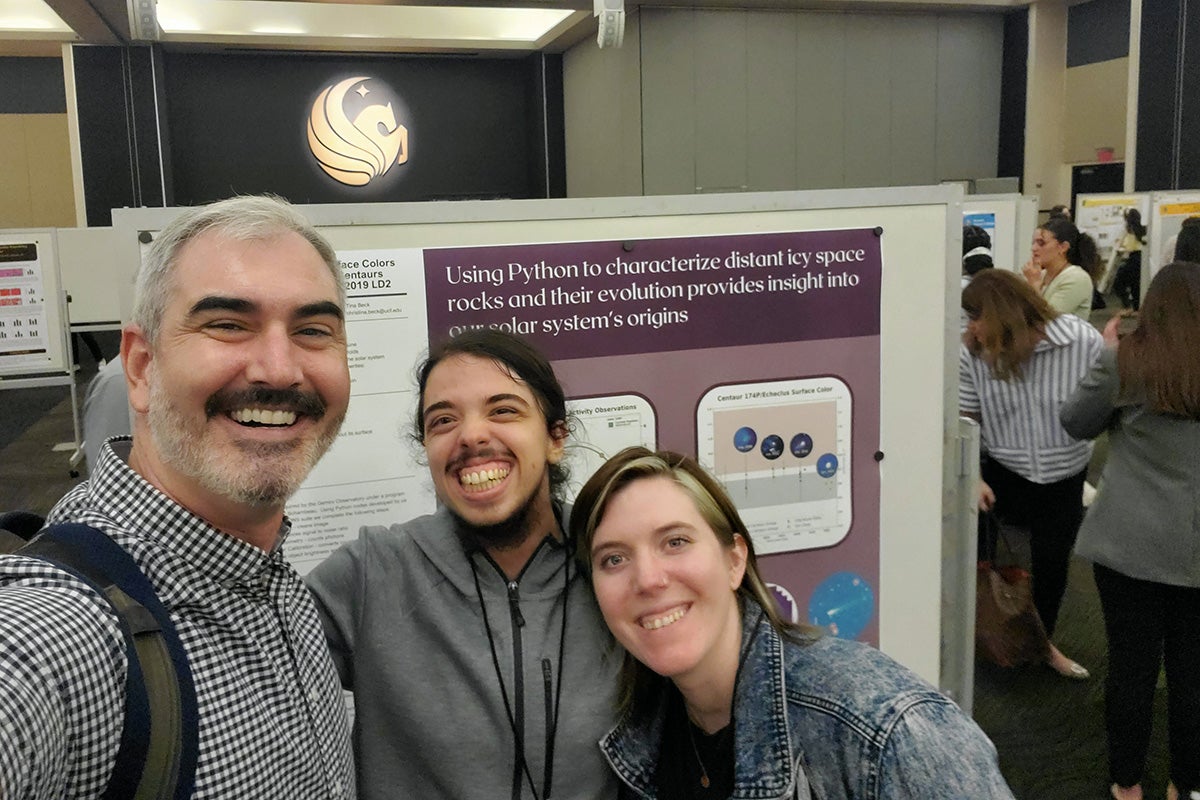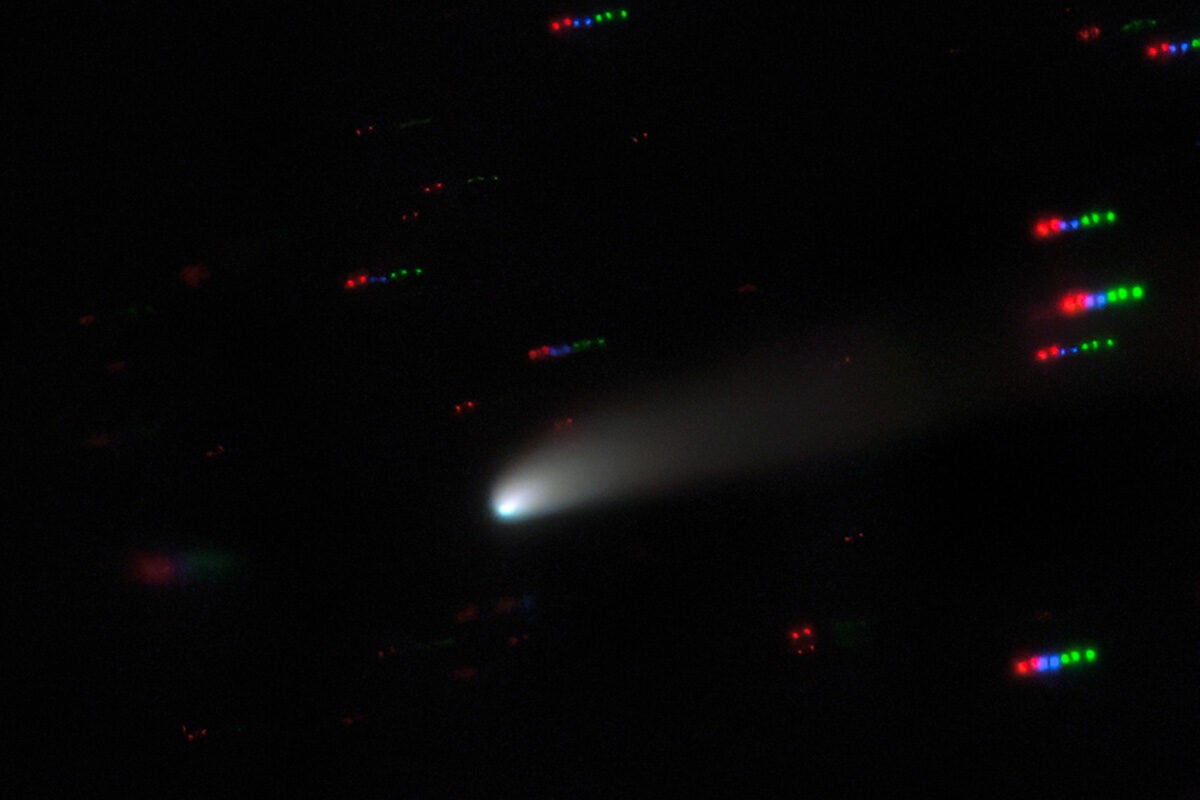A UCF researcher is working on a new, NASA-funded project that will gather the most comprehensive collection of data on active centaurs and distantly-active Jupiter-family comets to date.
The work will inform research into the origins of the solar system, as these bodies contain materials from the dawn of its formation.
Centaurs and Jupiter-family comets are small icy bodies that exist primarily in the outer regions of the solar system. While both are composed of a mixture of rock, dust and volatile substances, Jupiter-family comets are known for their cometary activity, such as comae and tails, while centaurs are often considered dormant. However, about 10% of known centaurs do display cometary-like activity.
“Centaurs and Jupiter-family comets have material in their nuclei interiors that we think is pretty pristine in the sense that their upper layers are really insulating, so the solar heating that’s incident on their surfaces doesn’t penetrate very deep,” says Charles Schambeau ’18PhD, an assistant scientist with UCF’s Florida Space Institute and the project’s principal investigator. “And so, if we can try to understand their interiors more, we will have a connection to that early, four-and-a-half billion-year-old set of conditions when they formed.”
The four-year, $500,000 NASA-funded project will use the Gemini Observatory’s twin 8.1-meter telescopes located in Chile and Hawaii to make observations of approximately 60 distantly active small icy bodies.
Schambeau and project co-investigator UCF Physics Professor Yan Fernandez have been leading a data collection effort of these objects since 2016, which is resulting in the largest and most comprehensive set of high-quality data on these types of objects to date. Receiving the new NASA award will enable the continuation of their program at least until 2026, Schambeau says.
The project team also includes collaborator Marco Micheli, a researcher with the European Space Agency.
Investigating Icy Bodies
The researchers will specifically investigate how the super volatiles carbon monoxide (CO) and carbon dioxide (CO2) are stored in the icy bodies, which remains a fundamental knowledge gap in the understanding of the formation and evolution of the solar system, Schambeau says.
If CO and CO2 are found to be frozen as bulk ices in Centaur nuclei interiors, then it means they were formed in a much colder environment than if CO and CO2 are found to be trapped inside of a porous form of ice known as amorphous water ice. For instance, if they are found to be frozen as bulk ice, the objects could have formed much farther from the Sun.
“The current state of super volatiles in these objects really gives a good constraint on the temperature under which these objects formed, and that gives us vital constraints that can be later used in solar system formation models,” Schambeau says.
The project so far has been amassing a large amount of imaging data on each individual object.
“One major goal of the project is to monitor each object’s comet-like activity behaviors over the course of an entire orbit around the Sun, which for centaurs can at times take decades,” he says. “We’re really in this for the long haul.”
Student Researchers
The large amount of data collected over a long time period has resulted in the project enlisting UCF undergraduate students to help develop software to streamline the data’s processing.
Recent UCF physics graduates Tina Beck ’23 and Seamus Walker ’23 have been working on the project since the fall of 2021 by helping with the data’s processing pipeline.
Both became interested in the work after they had been students in Schambeau’s astronomy class as undergraduates.

“I had a NASA internship during the summer of 2020 working with the preparations for the James Webb Space Telescope where I was exposed to an abundance of information regarding instrumentation, observation taking and data processing,” Beck says. “My interest in these subjects only grew as a result, leading me to pursue a better understanding of how we get from images to knowledge.”
“Upon hearing more about Dr. Schambeau’s research, I knew working with him would allow me to explore observational astronomy more deeply,” she says. “My interests in centaurs and cometary evolution developed as a direct result of working with him.”
Walker says working on the project has been a wonderful experience.
“This project has helped me grow during the course of my education at UCF, and I’ve learned so much because of it,” Walker says. “Working with specific objects becomes personal, and you get invested in looking at the data and figuring out more about each one.”
Beck and Walker’s work has focused on helping develop a software suite that converts raw images from telescopic observations into science-quality data ready for analysis, as well as beginning to characterize some of the objects they are studying.
“When you get these raw observations, there’s a lot of noise in them,” Walker says. “For example, high-energy particles might have hit your detector leaving you with streaks in the image. Our code helps to remove those artifacts and boost the signal we have for the objects that we’re interested in studying.”
Beck says the work has been fascinating and is the highlight of her undergraduate education at UCF.
“Centaurs are a body that as a community we do not fully understand, but they possess information that can help us unlock a better understanding of cometary evolution and thereby solar system evolution,” she says. “I thoroughly enjoy learning from Dr. Schambeau and the rest of the team.”
Future Observations
The team’s research using the Gemini Observatory is paving the way to incorporate future observations they will have from the upcoming Vera Rubin Observatory in Chile, which is scheduled to begin operations in mid 2025.
Rubin’s Legacy Survey of Space and Time (LSST) will provide almost nightly imaging data for many of the centaurs included in our program, Schambeau says.
“With the current Gemini Observations, the team has dedicated observations made of each specific icy body about twice a year, so the windfall of new data from the LSST is something the team is preparing for,” he says.
Researcher Credentials
Schambeau began the large and long-term observing campaign of centaurs and Jupiter-family comets as part of a NASA fellowship he received while a physics doctoral student in UCF’s Department of Physics. He received his doctorate in physics with a concentration in planetary sciences from UCF in 2018 and subsequently joined the Florida Space Institute where he continued the work as part of UCF’s Preeminent Postdoctoral Program. The funding for the new work is through NASA’s Shared Services Center.
Fernandez received his doctorate in astronomy from the University of Maryland, College Park. He spent 3-years (1999-2002) as a Scientific Researcher and 3-years (2002-2005) as a SIRTF/Spitzer Fellow in University of Hawai’i before joining UCF in 2005, where he is a professor in UCF’s Department of Physics, part of UCF’s College of Sciences.




